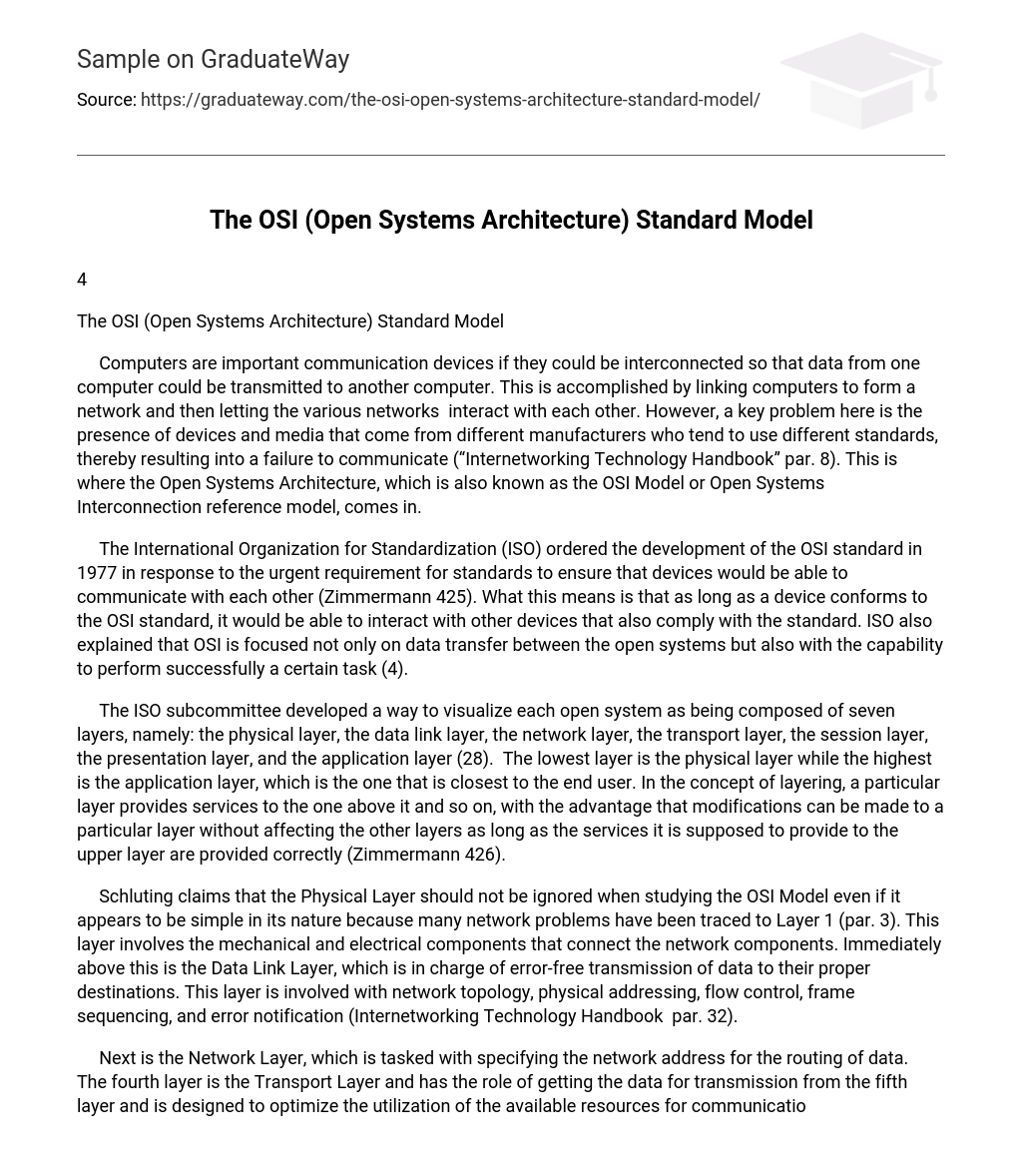Computers are important communication devices if they could be interconnected so that data from one computer could be transmitted to another computer. This is accomplished by linking computers to form a network and then letting the various networks interact with each other. However, a key problem here is the presence of devices and media that come from different manufacturers who tend to use different standards, thereby resulting into a failure to communicate (“Internetworking Technology Handbook” par. 8). This is where the Open Systems Architecture, which is also known as the OSI Model or Open Systems Interconnection reference model, comes in.
The International Organization for Standardization (ISO) ordered the development of the OSI standard in 1977 in response to the urgent requirement for standards to ensure that devices would be able to communicate with each other (Zimmermann 425). What this means is that as long as a device conforms to the OSI standard, it would be able to interact with other devices that also comply with the standard. ISO also explained that OSI is focused not only on data transfer between the open systems but also with the capability to perform successfully a certain task (4).
The ISO subcommittee developed a way to visualize each open system as being composed of seven layers, namely: the physical layer, the data link layer, the network layer, the transport layer, the session layer, the presentation layer, and the application layer (28). The lowest layer is the physical layer while the highest is the application layer, which is the one that is closest to the end user. In the concept of layering, a particular layer provides services to the one above it and so on, with the advantage that modifications can be made to a particular layer without affecting the other layers as long as the services it is supposed to provide to the upper layer are provided correctly (Zimmermann 426).
Schluting claims that the Physical Layer should not be ignored when studying the OSI Model even if it appears to be simple in its nature because many network problems have been traced to Layer 1 (par. 3). This layer involves the mechanical and electrical components that connect the network components. Immediately above this is the Data Link Layer, which is in charge of error-free transmission of data to their proper destinations. This layer is involved with network topology, physical addressing, flow control, frame sequencing, and error notification (Internetworking Technology Handbook par. 32).
Next is the Network Layer, which is tasked with specifying the network address for the routing of data. The fourth layer is the Transport Layer and has the role of getting the data for transmission from the fifth layer and is designed to optimize the utilization of the available resources for communication (Zimmermann 430). It should be observed that the first four layers are involved with data transport (Internetworking Technology Handbook par. 17).
The fifth to the seventh layers are involved with application problems and executed only through software (Internetworking Technology Handbook par. 16). Layer 5 is the Session Layer and is in charge of taking control of communication sessions between two systems. It provides two kinds of services: the starting and termination of a session; and the regulation of data operations with the assistance of the Transport Layer (Zimmermann 430).
The sixth layer is the Presentation Layer, which is in charge of the proper interpretation of data by converting its format into something that the topmost layer could understand (Internetworking Technology Handbook par. 41). Thus, this layer is tasked with the handling of data formats, such as TIF, JPG, and others. It is also involved with the formats employed in data compression and encryption. The seventh layer is the Application Layer and interacts with the user and the program that requires network communication, such as an email messaging system (Zimmermann 430).
The significance of the OSI Model is found in its simple and basic structure that defines open systems. Because the functions and services required have been grouped based on similarity, it is easy to make adjustments on a particular layer without the need to take into account the other layers as long as the services that it provides to the next layer are not affected (Zimmermann 426).
Because of its simplicity, it could be utilized as the reference on which more complicated standards could be devised. This is how the OSI standard serves the world of communication. It provides a starting point for those who would like to develop a more specific internetworking standard.
Another important contribution of the OSI Model is that it offers a way for students of computer networking to easily grasp the concepts involved in this field. Thus, it would be helpful to devise a way to help the student in easily memorizing the seven layers. One such technique is to memorize a phrase with the first letter of each word corresponding to the first letter of each layer.
A possible phrase that is of course related to networking is “A Problem Solved To Network Data & People.” Take note that the A represents “Application,” the P represents “Presentation,” S represents “Session,” T represents “Transport,” N represents “Network,” D represents “Data Link,” and P represents “Physical.” The phrase could also be made more memorable by making it a bit humorous, such as the phrase “A Person So Thin, No Diet Please.”
Works Cited
- Information Technology—Open Systems Interconnection—Basic Reference Model: The Basic Model. ISO/IEC Standard 7498-1. 1996. Geneva, Switzerland: 1994.
- Internetworking Technology Handbook. Cisco Systems Inc. <http://www.cisco.com/en/US/docs/internetworking/technology/handbook/Intro-to-Internet.html#wp1020552>.
- Schluting, Charlie. The OSI Reference Model—Understanding Layers. 13 January 2005. <http://www.webopedia.com/DidYouKnow/Computer_Science/2006/understanding_layers.asp>.
- Zimmermann, Hubert. “OSI Reference Model—The ISO Model of Architecture for Open Systems Interconnection.” IEEE Transactions on Communications April 1980: 425-432.





